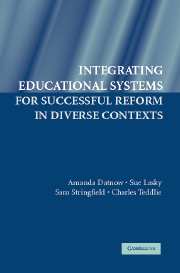Book contents
- Frontmatter
- Contents
- List of Figures and Tables
- Acknowledgments
- 1 Introduction
- 2 School Effectiveness and Improvement
- 3 District-Level Reform Efforts
- 4 Community-Level Reform Efforts
- 5 State-Level Reform Efforts
- 6 The Role of Reform Design Teams
- 7 The Role of the Federal Government in Reform Efforts
- 8 Methodological Issues in the Study of Systemic Integration for Effective Reform
- 9 Discussion and Conclusion
- Bibliography
- Index
1 - Introduction
Published online by Cambridge University Press: 02 September 2009
- Frontmatter
- Contents
- List of Figures and Tables
- Acknowledgments
- 1 Introduction
- 2 School Effectiveness and Improvement
- 3 District-Level Reform Efforts
- 4 Community-Level Reform Efforts
- 5 State-Level Reform Efforts
- 6 The Role of Reform Design Teams
- 7 The Role of the Federal Government in Reform Efforts
- 8 Methodological Issues in the Study of Systemic Integration for Effective Reform
- 9 Discussion and Conclusion
- Bibliography
- Index
Summary
PURPOSE
This book reports the findings of an extensive review of literature of research on educational reform in school systems serving racially and linguistic minority youth. Our aim is to identify strategies for supporting reform in educational settings serving these students. In doing so, we place particular emphasis on identifying the linkages between systemic levels (e.g., school, district, community) that are important in the process of school improvement.
Thus, the purpose of the volume is to develop an understanding of what might be needed at the teacher, school, district, state, and federal levels for educational reform to be successful in multicultural, multilingual settings. We define reform as an innovation intended to improve education (e.g., standards-based reform, site-based management, school reconstitution), rather than simply a change for change sake. We know from prior research that reform will rarely succeed without coordinated support from multiple levels (e.g., school, district, state), and that reform is rarely sustained if built on technical models alone. Political support and belief changes are required at multiple levels of the system. Instead of trying to identify “one best system,” the goal of this volume is to identify approaches that are adaptable and contextually sensitive. In particular, our aim is to identify strategies for supporting reform in school systems serving culturally and linguistically diverse communities.
RULES OF EVIDENCE AND INCLUSION
This review of research covers studies that were conducted between 1983 and 2004. However, the majority of research reviewed was conducted between the mid-1990s and 2003.
- Type
- Chapter
- Information
- Publisher: Cambridge University PressPrint publication year: 2006

